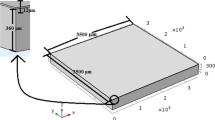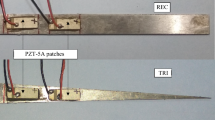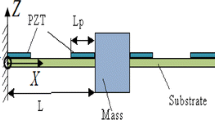Abstract
By use of the concept of impedance, this paper establishes a random energy harvester output model of double-ended fixed beam piezoelectric energy harvester under random White Gaussian noise excitation, which is based on the discussion of the output characteristics influenced by changing vibration beam shape and piezoelectric sheet length under random excitation, while improving piezoelectric structure of double-ended fixed beam piezoelectric energy harvester. It also deduces the output voltage, current and power of energy harvester with Fokker–Planck equation, which are verified by Monte Carlo simulation and experimental testing. It can be found that improving vibration beam shape can reduce resonant frequency and increase average output power of the system. The optimal value of piezoelectric sheet length can be different corresponding to different structures, which proves that double-ended fixed beam piezoelectric energy harvester under random White Gaussian noise excitation can achieve maximum output with optimal piezoelectric sheet length. In addition, in order to further improve the output performance of piezoelectric energy harvester under random excitation, it is necessary to increase the acceleration spectral density under random excitation and set an optimal value of the piezoelectric loading resistance, which is more suitable for energy harvester applied under random low-frequency environment.






Similar content being viewed by others
References
Ling, C. S., Dan, H., Steve, G. B. (2013). Technological challenges of developing wireless health and usage monitoring systems. In Proceedings of SPIE 2013.vol. 8695, p. 86950K-1.
Karami, M. A., & Inman, D. J. (2012). Powering pacemakers from heartbeat vibrations using linear and nonlinear energy harvesters. Applied Physics Letters,100, 042901.
Nicholas, R., Natarajan, B. (2013). A structured approach to optimization of energy harvesting wireless sensor networks. In The 10th annual IEEE CCNC 2013, pp. 420–425.
Tiwari, R., Buch, N., & Garcia, E. (2014). Energy balance for peak detection method in piezoelectric energy harvester. Journal of Intelligent Material Systems and Structures,25, 1024–1035.
Yang, X., Wang, Y., & Cao, Y. (2014). A new hybrid piezoelectric-electromagnetic vibration-powered generator and its model and experiment research applied superconductivity. IEEE Transactions on Applied Superconductivity,24, 1–4.
Marin, A., Turner, J., & Ha, D. S. (2013). Broadband electromagnetic vibration energy harvesting system for powering wireless sensor nodes. Smart Materials and Structures,22, 075008.
Cao, Lianmin, Zhang, Yazhu, Sun, Shi-jiao, et al. (2018). Structure design and test of MEMS thermocouple infrared detector. Microsystem Technologies,24(5), 2463–2471.
Ren, Y. S., Tian, J. S., Liu, Y. L., et al. (2019). Nonlinear deformation, thermal buckling and vibration of shape memory alloy fiber composite beams. Journal of Shandong University of Science and Technology (Natural Science Edition),01, 99–110.
Goldschmidtboeing, F., & Woias, P. (2008). Characterization of different beam shapes for piezoelectric energy harvesting. Journal of Micromechanics and Microengineering,18(10), 104013.
Muthalif, A. G. A., & Nordin, N. H. D. (2015). Optimal piezoelectric beam shape for single and broadband vibration energy harvesting: Modeling, simulation and experimental results. Mechanical Systems and Signal Processing,54, 417–426.
Hosseini, R., & Hamedi, M. (2015). Improvements in energy harvesting capabilities by using different shapes of piezoelectric bimorphs. Journal of Micromechanics and Microengineering,25(12), 125008.
Tabatabaei, S. M. K., Behbahani, S., & Rajaeipour, P. (2016). Multi-objective shape design optimization of piezoelectric energy harvester using artificial immune system. Microsystem Technologies,22(10), 2435–2446.
Cao, Lianmin, Li, Zhixu, Guo, Cheng, et al. (2019). Design and test of the MEMS coupled piezoelectric electromagnetic energy harvester. International Journal of Precision Engineering and Manufacturing,20(4), 673–686.
Dietl, J. M., & Garcia, E. (2010). Beam shape optimization for power harvesting. Journal of Intelligent Material Systems and Structures,21(6), 633–646.
Chandrasekharan, N., Ju, J., & Thompson, L. (2013). Effects of geometric and material properties on electrical power harvested from a bimorph piezoelectric cantilever beam. Multidiscipline Modeling in Materials and Structures,9(3), 391–409.
Sunithamani, S., & Lakshmi, P. (2015). Simulation study on performance of MEMS piezoelectric energy harvester with optimized substrate to piezoelectric thickness ratio. Microsystem Technologies,21(4), 733–738.
Shafer, M. W., Bryant, M., & Garcia, E. (2012). Designing maximum power output into piezoelectric energy harvesters. Smart Materials and Structures,21(8), 085008.
Daqaq, M. F. (2010). Response of uni-modal duffing-type harvesters to random forced excitations. Journal of Sound and Vibration,329(18), 3621–3631.
Daqaq, M. F. (2011). Transduction of a bistable inductive generator driven by white and exponentially correlated Gaussian noise. Journal of Sound and Vibration,330(11), 2554–2564.
Daqaq, M. F. (2012). On intentional introduction of stiffness nonlinearities for energy harvesting under white Gaussian excitations. Nonlinear Dynamics,69(3), 1063–1079.
Sebald, G., Kuwano, H., Guyomar, D., et al. (2011). Simulation of a Duffing oscillator for broadband piezoelectric energy harvesting. Smart Materials and Structures,20(7), 075022.
Green, P. L., Worden, K., Atallah, K., et al. (2012). The benefits of Duffing-type nonlinearities and electrical optimisation of a mono-stable energy harvester under white Gaussian excitations. Journal of Sound and Vibration,331(20), 4504–4517.
Zhao, Z. H., Wang, Y. P., et al. (2008). Solving of the dynamic problem of Piezo-compound structure based on FEPG. Journal of Shandong University of Science and Technology (Natural Science Edition),05, 66–70.
Acknowledgements
This work is supported by the funds of the the first batch of national virtual simulation experiment teaching project, China (No. 201806022) and overseas visiting project jointly sponsored by Shandong Province and Shandong University of Science and Technology.
Author information
Authors and Affiliations
Corresponding author
Additional information
Publisher's Note
Springer Nature remains neutral with regard to jurisdictional claims in published maps and institutional affiliations.
Rights and permissions
About this article
Cite this article
Cao, L., Cai, Y., Xu, G. et al. Research on Output Characteristics of Double-Ended Fixed Beam Piezoelectric Energy Harvester Under Random Excitation. Int. J. Precis. Eng. Manuf. 21, 1075–1083 (2020). https://doi.org/10.1007/s12541-020-00322-y
Received:
Revised:
Accepted:
Published:
Issue Date:
DOI: https://doi.org/10.1007/s12541-020-00322-y




